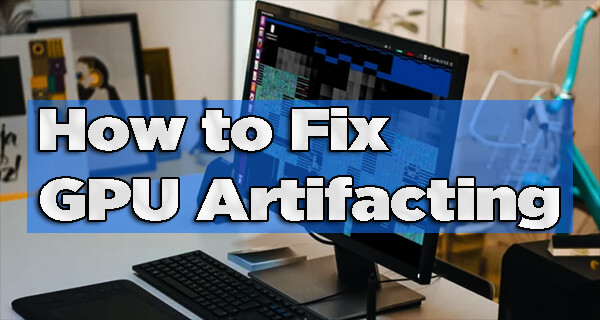GPU artifacting can be a frustrating issue, causing distorted graphics and other visual glitches. This guide offers valuable insights on diagnosing and fixing these problems, providing a smoother computing experience.

What is GPU Artifacting?
GPU artifacting refers to the appearance of visual anomalies or glitches on your computer screen when the GPU is under load. These anomalies can manifest as distorted images, screen tearing, flickering, or random colored pixels. Artifacting occurs due to various reasons, including hardware and software issues.
What Causes GPU Artifacting?
Understanding the root causes of GPU artifacting is crucial for effective troubleshooting. Some common culprits include:
Overheating: Excessive heat can cause solder connections on the GPU to weaken, leading to artifacting.
Driver Issues: Outdated or corrupt graphics card drivers can trigger graphical glitches.
Overclocking: Pushing your GPU beyond its designed limits can result in artifacting.
Physical Damage: Damage to the GPU or its connectors may lead to artifacting.
Insufficient Power: A weak or failing power supply unit (PSU) can cause voltage irregularities and artifacting.
Signs and Symptoms –
Before attempting any fixes, you should be able to identify the symptoms of GPU artifacting. Common signs include:
- Screen flickering or flashing
- Artifacts appearing as random pixels or lines
- Graphics glitches in games or applications
- Screen tearing during video playback or gaming
- Freezing or crashing of the display driver
Testing for GPU Artifacting –
To confirm that your GPU is indeed artifacting, run some diagnostic tests.
Benchmark Tests: Use 3DMark or Heaven Benchmark to stress-test your GPU.
Real-World Usage: Observe your system’s behavior during demanding tasks like gaming or video rendering.
Artifact Scanners: Some software tools, such as OCCT, can specifically detect and report artifacting.
Monitoring GPU Temperature –
Overheating is a common cause of artifacting. Use monitoring tools like MSI Afterburner or HWMonitor to check your GPU’s temperature while it’s under load. If it consistently reaches high temperatures (above 80°C), consider cooling solutions.
How to Fix GPU Artifacting –
Now that you’ve confirmed GPU artifacting, let’s explore how to fix it.
a) Cleaning Your GPU:
Dust accumulation can hinder your GPU’s cooling efficiency. Turn off your computer, unplug it, and carefully clean your GPU and its fans using compressed air or a soft brush. This simple step can often resolve artifacting issues caused by overheating.
b) Updating GPU Drivers:
Outdated or corrupt drivers can lead to graphical problems. Visit the official website of the GPU manufacturer (NVIDIA, AMD, Intel) and you can download the latest drivers. Ensure you perform a clean installation to eliminate any existing driver issues.
c) Overclocking and Underclocking:
If you’ve overclocked your GPU, revert it to its default clock speeds. Overclocking can lead to instability and artifacting. Conversely, if your GPU is old or prone to overheating, you may underclock it slightly to reduce heat generation.
d) Checking for Physical Damage:
Examine your GPU for physical damage, such as bent or broken connectors, burnt components, or loose connections. If you find any issues, consult a professional technician for repairs.
e) Replacing the GPU:
If all else fails and your GPU continues to artifact, it may be time to consider a replacement. GPUs can degrade over time, and some issues are irreparable.
GPU Artifacting on Startup –
Startup GPU artifacting is a frustrating issue that can stem from hardware or software problems. To fix it, start with basic checks like ensuring secure GPU connections. Then, update drivers, inspect for physical damage, and consider potential software conflicts. If troubleshooting doesn’t work, seek professional assistance.
Preventing GPU Artifacting –
Prevention is the best way to avoid GPU artifacting in the future. Here are some tips:
Maintaining Proper Cooling –
Ensure your computer case has adequate ventilation and invest in quality cooling solutions. Good airflow can significantly extend the life of your GPU.
Using Quality Power Supply Units (PSUs) –
A reliable PSU delivers stable power to your GPU. Invest in a PSU from a reputable brand with sufficient wattage to meet your system’s needs.
Avoiding Overclocking –
While overclocking can boost performance, it can also lead to hardware degradation. Only overclock if you’re experienced and willing to accept the risks.
Keeping a Dust-Free Environment –
Regularly clean your computer and its components to prevent dust buildup. Dust can exacerbate overheating issues.
Conclusion:
While dealing with GPU artifacting may be challenging, this guide equips you with effective solutions. From cleaning and driver updates to prevention measures, addressing GPU issues becomes manageable. By following these steps, you can ensure optimal GPU performance.
FAQs –
Q. Can you repair an artifacting GPU?
Answer: Repairing an artifacting GPU is possible in some cases, such as fixing loose connections or damaged components. However, more severe issues may require professional help or GPU replacement.
Q. What to do when GPU is artifacting?
Answer: When your GPU is artifacting, start by checking connections, updating drivers, and cleaning the GPU. If problems persist, consider underclocking or seeking professional assistance.
Q. Is GPU artifacting permanent?
Answer: GPU artifacting is not always permanent. It can result from various factors, and some issues, like overheating or driver problems, can be resolved, while others may require hardware replacement.
Q. Can underclocking fix artifacts?
Answer: Underclocking your GPU can sometimes help reduce artifacts, especially if they are caused by overheating or overclocking. It can provide temporary relief while addressing the underlying issue.
